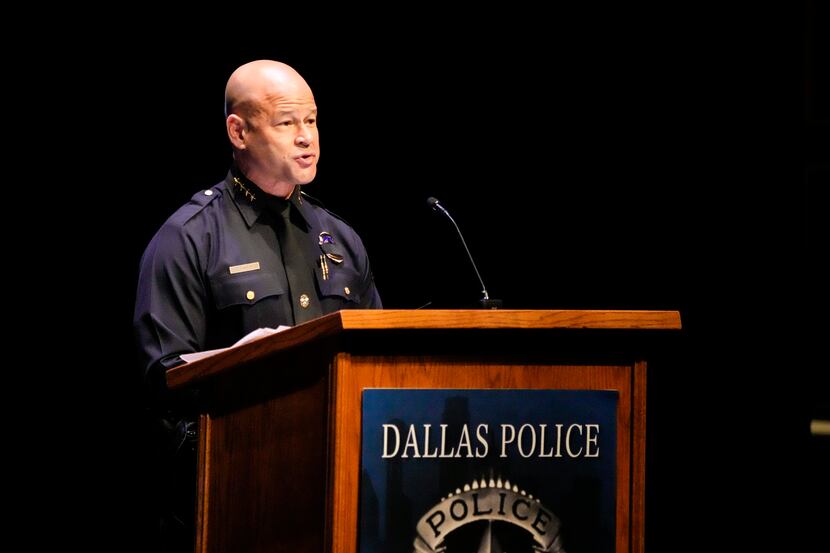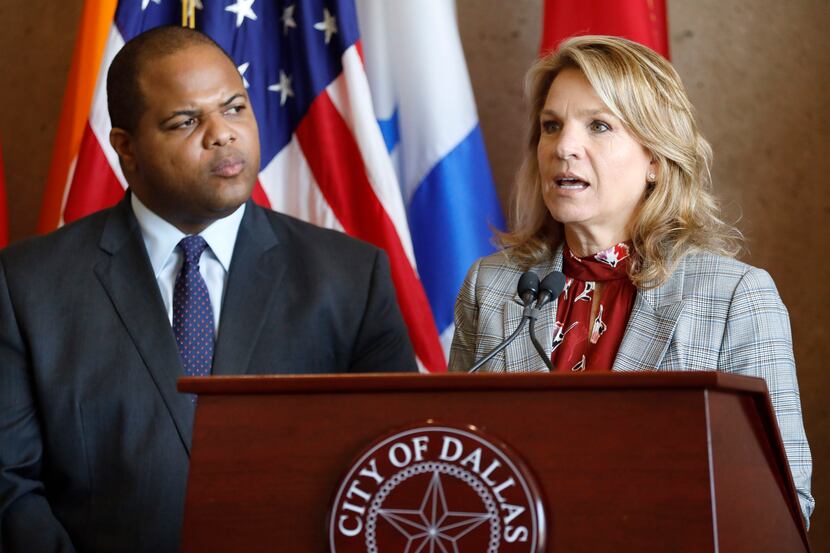Dallas police Chief Eddie García didn’t need any “October is domestic violence awareness month” reminder on his calendar to prod him into action to try to stop these pernicious crimes.
In his previous job as chief in San Jose, Calif., García was often at the side of Bay Area residents Rick and DiAnn Beatty as they advocated for more effective laws after their daughter Alessandra was murdered in 2015 by an intimate partner who had already been convicted of assault with a deadly weapon in another state.
Each time the Beattys recounted details of the tragedy, García reminded himself: Police may be only one piece of the solution, but we must be committed to making it our responsibility. My department will always show that it really cares.
García had been on his new job in Dallas for only a week when a man killed his girlfriend and her mother Feb. 7 in the apartment the three shared, then fatally shot himself during an afternoon standoff with SWAT officers.
The first patrol officers on the scene barely escaped injury when Nathan Rashad James shot at them and shattered patrol car windows.
Less than two weeks later, on the morning of Feb. 18, a man murdered his wife in their Old East Dallas home and wounded two officers called to the scene.
Sergio Sanchez, who twice had been convicted of sexual assault, killed himself before SWAT officers got inside.

García’s reaction to both Dallas incidents was, “This is ridiculous. We’ve got to do more about this.”
Even before his official start date, García had worked on the overall violent crime reduction plan that he officially presented in May. He knew domestic violence — crimes that usually occur not on street corners but behind closed doors — would need its own blueprint.
Today I’ve got your first look at the details of what García and the Dallas Police Department plan to do to try to reduce these crimes. The plan will be unveiled at noon Monday at City Hall and briefed to the City Council’s Public Safety Committee Tuesday.
The strategy includes reorganizing the police department’s family violence unit, resuming visits to the homes of vulnerable survivors and breaking down walls between the homicide and intimate-partner violence detectives.
Before getting into the nuts and bolts, it’s worth spending a minute celebrating an excellent early trend emerging from García’s overall strategy: As arrests grow for murders, robberies and aggravated assaults in targeted “hot spots,” domestic violence cases in those areas have fallen.
“The same individuals who are shooting, stabbing and doing other things on the streets are also committing violence against their partner,” García told me. “If you’re violent, you’re violent.”
García’s violent crime reduction plan is data-driven and increases police visibility in “micro-locations” to tackle violence and pay special attention to repeat offenders.
About five months into the new strategy, citywide crime reports are trending downward. The number of domestic violence felonies, up 13.6% in 2020 from 2019, remains virtually flat this year.
None of that has made García rest easier, especially after the domestic violence tragedies his department dealt with his first month on the job.

“Both times those guys shoot at my cops. Both times they kill their partner,” he said as he recounted the two February crimes to me. The rhetorical question — “How did we get here?” — was his starting point for making changes.
The first reality, as García and advocates will remind you, is that the Dallas Police Department — while it can and must do more — is only one cog in the solution. Nonprofits, social service organizations, and local and federal prosecutors and courtrooms must pull their weight too.
Following the lead of criminologists, here’s how the police will change their tactics:
For seemingly forever, the family violence unit has handled both intimate-partner violent crime — which 90% of the time is a man who harms his partner — and other family violence offenses — for example, when a 17-year-old punches his father.
By adding more detectives to the unit, one group will deal exclusively with intimate-partner violence and another with general family violence.
García believes this division of labor will make investigations more efficient and affirm that the department understands the nuanced differences in the two types of offenses.
“We should have much more contact with our survivors and have more of that personal touch that you really need to have,” he said. Not to mention that the case of a woman nearly choked to death is far different than that of the teen who takes a swing at his dad.
The department also will resume home visits, with help from data analysis of vulnerable situations. This is only possible, García said, because the City Council, with Mayor Eric Johnson in the lead, restored $10 million in overtime funds in its final budget vote.
These visits tell the survivor, “We care, we’re here and what do you need?” García said. They warn the possible repeat offender, “We’re here, we care and you might want to watch your P’s and Q’s because you are on our grid.”
Additionally, an intimate-partner violence detective will respond in real time alongside homicide detectives in cases in which a murder might have a family violence component.
García acknowledged that these are situations in which “we have all failed because someone is dead.” But the response allows the team to put together the best case possible and, by fully understanding each tragedy, “we learn something that might help other victims in the future.”
He said he also intends for his department to partner with the local U.S. attorney’s office on the most serious cases to get federal prosecutions, when warranted, on firearms charges.
García described his goal as, “I want results, so let’s try things to see if we can help someone. If something doesn’t work, we’ll think of something else.”

Johnson told me it’s a relief to have a police chief who is leading public safety efforts — both overall and in regard to domestic violence — with a “well-thought-out, comprehensive plan — and one we didn’t have to talk him into doing.”
The mayor recognizes that domestic violence is a complicated problem with deep roots in socioeconomic and structural conditions.
Research-backed factors cited in García’s report say much the same. At the highest risk are women, especially those ages 16 to 24 and those who live in poverty. Victimization rates are 35% higher among Black women compared to white. Other factors include prior incidents, alcohol use and physical abuse experienced in childhood.
“Even though this crime takes place behind closed doors and victims may think that no one is even aware of their suffering, we are,” Johnson said. “We aren’t throwing up our hands. We’re going to throw every resource we have at this.”
Johnson also worries about the children whose development is affected “for the rest of their lives by witnessing this type of violence or being victims of it themselves.”
García’s plan builds on the recommendations long lobbied for by the domestic violence task force long led by former City Council member Jennifer Staubach Gates and recently renamed the Mayor’s Domestic Violence Advisory Council.
“Now he [García] will need all the community pitching in on the things that are out of his control,” said Gates, who continues to head the domestic violence group.
Partners must work even harder on best practices such as public awareness campaigns, enlisting the help of loved ones and neighbors to call the police, and screening for domestic violence in hospitals and physicians’ offices.
The judicial system also has work to do: Lowering the barriers to obtaining protective orders; meaningful pretrial release conditions to reduce the likelihood of future offenses; prosecution even without victim cooperation; and evidence-based treatment programs for offenders.
García still has a lot to prove. But the time he’s put into finding thoughtful next steps on domestic violence is an example of why residents can feel pretty confident about this hire.
Our new chief takes crime very personally — without getting defensive about it. As best I can tell, he genuinely wants to be that guy who becomes a part of our city and solves the problems in front of him.
“Let’s lock arms on domestic violence and do this,” he told me. “It’s part of what’s going to ultimately save our city.”

